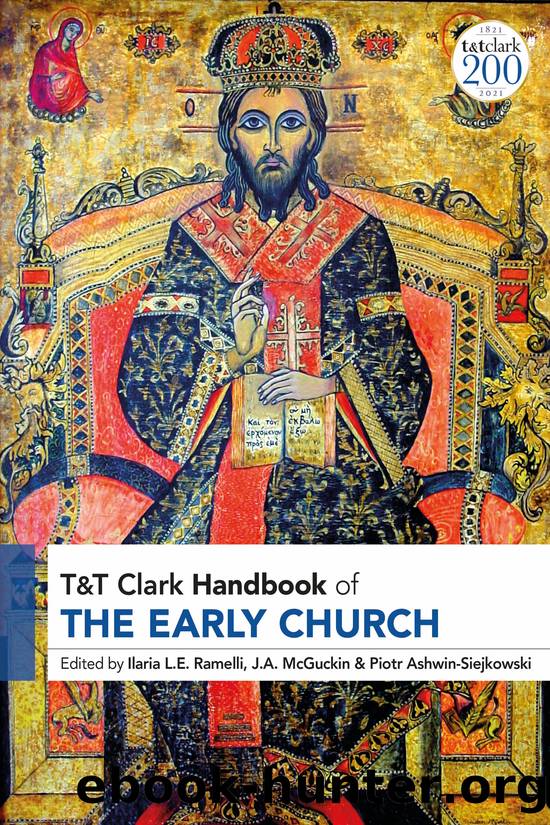T&T Clark Handbook of the Early Church by Ilaria L.E. Ramelli;J.A. McGuckin;Piotr Ashwin-Siejkowski;

Author:Ilaria L.E. Ramelli;J.A. McGuckin;Piotr Ashwin-Siejkowski;
Language: eng
Format: epub
ISBN: 9780567680396
Publisher: Bloomsbury UK
Chapter 18
Graeco-Roman and Christian art in late antiquity
JaÅ Elsner
Introduction: Some working assumptions
Let us begin with some propositions, not universally shared in the history of the study of early Christian art, but which will form the basis of the argument put forward here.
1. Early Christian art is just one among the religious arts generated within the glory-period of religious creativity and multiplicity of the Roman Empire from the second to the fourth century ad. It is thus not a unique or special development, but intrinsically related to a broad competitive context of parallel religious affiliations, identities and self-assertions (from ancient civic cults like the worship of Artemis of Ephesus, ancient mystery religions like the initiations at Eleusis and ancient tribal or local cults like Judaism via modern revivals and adaptations of foreign cults like that of Isis or Dionysus or Cybele and Attis to what appear to be new religions like Mithraism and Christianity), many of them more or less semi-detached from official state or civic religion.1
2. Christianity is not unique in any special way among these religions (any more than each of the others is exceptional),2 but it has certain special features which are fundamental to the development of its art. These include the fact that (along with Judaism) Christianity possessed a set of written scriptures, of which certain elements rapidly became canonical, while others were established as less significant but nonetheless broadly acceptable (a wide range of items from the Old and New Testament apocrypha to such texts as the Protoevangelium of James and the various saintsâ lives and martyr-acts whose literary level and market seem connected to the ancient novel)3 and still others became âhereticalâ. Clearly the existence of scripture meant that visual imagery could be related to a canonical set of texts (though whether the manner of that relation was didactic, illustrative, commentarial or exegetic was a complex and in some corners a charged point). We need to beware exaggeration. It is not certain that some of the other cults did not have parallel âscripturalâ traditions preserved orally and through memorization (this would certainly explain the stereotypical â or at least repeated â nature of some complex Mithraic imagery): there is no evidence for this, but there would not be in a lost religion (like Mithraism) whose sacred lore was oral â Buddhism, which preserved a very large number of very early scriptures in an oral memorized form only wrote those down after several centuries, and had the religion been entirely lost after say two centuries (like Mithraism or the cult of Jupiter Dolichenus) we would be wrong in our (methodologically correct but reductivist) assumption that it had no scriptures because none were preserved.
3. âChristianityâ in the early period is a dangerous generalization, since there were numerous local and regional varieties, multiple theologies, a complex culture of dispute and disagreement (partly the product of that very literacy which made Christianity special).4 The very genesis of Christian art has in one argument been attributed to this competitive pluralism of views and
Download
This site does not store any files on its server. We only index and link to content provided by other sites. Please contact the content providers to delete copyright contents if any and email us, we'll remove relevant links or contents immediately.
| Africa | Americas |
| Arctic & Antarctica | Asia |
| Australia & Oceania | Europe |
| Middle East | Russia |
| United States | World |
| Ancient Civilizations | Military |
| Historical Study & Educational Resources |
Cecilia; Or, Memoirs of an Heiress — Volume 1 by Fanny Burney(32067)
Cecilia; Or, Memoirs of an Heiress — Volume 3 by Fanny Burney(31463)
Cecilia; Or, Memoirs of an Heiress — Volume 2 by Fanny Burney(31413)
The Secret History by Donna Tartt(18188)
Sapiens: A Brief History of Humankind by Yuval Noah Harari(13994)
Leonardo da Vinci by Walter Isaacson(12809)
The Radium Girls by Kate Moore(11626)
Sapiens by Yuval Noah Harari(5125)
How Democracies Die by Steven Levitsky & Daniel Ziblatt(4966)
The Wind in My Hair by Masih Alinejad(4849)
Homo Deus: A Brief History of Tomorrow by Yuval Noah Harari(4692)
Endurance: Shackleton's Incredible Voyage by Alfred Lansing(4511)
Man's Search for Meaning by Viktor Frankl(4295)
The Silk Roads by Peter Frankopan(4275)
Millionaire: The Philanderer, Gambler, and Duelist Who Invented Modern Finance by Janet Gleeson(4106)
The Rape of Nanking by Iris Chang(4024)
Hitler in Los Angeles by Steven J. Ross(3803)
The Motorcycle Diaries by Ernesto Che Guevara(3789)
Joan of Arc by Mary Gordon(3787)
